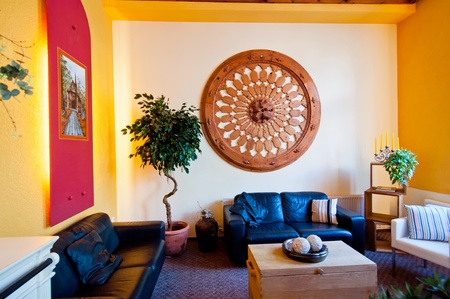The Legacy of Handcrafted Furniture in Indian Homes
Handcrafted furniture has always played a pivotal role in the story of Indian homes. From the intricate woodwork of Rajasthan to the refined cane artistry of Kerala, each piece is a testament to India’s rich and diverse tradition. These creations are not merely utilitarian; they reflect the deep connection between art, heritage, and everyday living. For generations, Indian families have cherished wooden swings (jhoolas), ornate almirahs, and carved chowkis as symbols of their lineage and pride. The skills and techniques passed down through centuries continue to thrive in small towns and bustling cities alike, blending time-honoured craftsmanship with contemporary needs. In Indian culture, furniture is more than just a household item – it embodies family memories, rituals, and milestones. Handcrafted pieces are lovingly maintained and often handed over from one generation to the next, forming an emotional bridge that keeps family heritage alive within the home.
2. Indian Craftsmanship: Skills Passed Through Generations
India is celebrated globally for its remarkable handcrafted furniture, a living testament to the country’s rich artisanal heritage. Each region in India boasts its own distinct craftsmanship techniques, honed over centuries and deeply interwoven with local culture and family traditions. From the intricate wood carving of Saharanpur in Uttar Pradesh to the vibrant painted furniture of Rajasthan and the elegant cane work of Assam, Indian artisans possess a treasure trove of skills that have been lovingly passed down through generations.
The Diversity of Regional Techniques
Every state in India brings forth unique materials and design philosophies, making Indian handcrafted furniture both diverse and highly sought after. Below is a table highlighting some key regional techniques and their distinctive features:
Region |
Key Material |
Signature Technique |
Notable Features |
|---|---|---|---|
| Saharanpur, Uttar Pradesh | Sheesham Wood (Indian Rosewood) | Intricate Hand Carving | Detailed floral and geometric patterns; traditional motifs |
| Rajasthan | Mango Wood, Teak | Hand Painting & Inlay Work | Bold colours, Rajasthani folk art, mirror work accents |
| Kashmir | Walnut Wood | Papier-mâché & Wood Carving | Khatamband (geometric ceiling panels), delicate engravings |
| Assam & Kerala | Bamboo, Cane | Weaving & Joinery | Sustainable designs, lightweight yet sturdy structures |
| Tamil Nadu | Rosewood, Mahogany | Chettinad Style Carving | Pillared designs, temple motifs, traditional South Indian aesthetics |
The Family Heritage of Craftsmanship
For many Indian artisans, these expert skills are not just a means of livelihood but an integral part of their family identity. The knowledge is often shared from parent to child within the home or small community workshops, where elders mentor the younger generation in time-honoured methods. This process not only preserves traditional techniques but also strengthens familial bonds and instils a deep sense of pride in one’s heritage.
The Emotional Connect: More Than Just Furniture
The result is handcrafted furniture that carries stories—each piece reflects countless hours of labour, love, and shared wisdom. Customers across India cherish such pieces not only for their beauty but also for their emotional significance; they represent continuity, nostalgia, and the enduring value of family traditions. Whether displayed in a modern apartment or an ancestral haveli, handcrafted Indian furniture stands as a symbol of cultural pride and personal connection.

3. A Symbol of Family Heritage and Pride
In Indian homes, handcrafted furniture is far more than mere decor; it is a cherished symbol of family heritage and pride. Each intricately carved wooden swing, sturdy rosewood table, or ornate almirah often tells the unique story of generations—reflecting the skilled hands of artisans and the loving care of ancestors. For many families across India, such furniture pieces are considered priceless heirlooms, passed down from grandparents to parents and then to children. These treasures are not simply preserved for their material value, but for the emotional connect they foster within the family. Owning a piece of handcrafted furniture evokes memories of shared meals, festivals, and milestones celebrated together around them. It becomes a living testimony to the familys journey, resilience, and values.
4. Handcrafted Furniture and Indian Home Decor
Handcrafted furniture occupies a special place in Indian home decor, where every piece tells a story of skilled artisanship and cultural richness. In India, the concept of home extends beyond mere shelter—its an evolving canvas reflecting personal taste, family tradition, and regional identity. Traditional handcrafted furniture seamlessly blends function with artistry, creating spaces that are both practical and aesthetically captivating.
The Harmony of Functionality and Artistry
Indian homes require furniture that is not only beautiful but also robust enough to withstand daily use by large families and frequent guests. Handcrafted pieces—like intricately carved wooden diwans, jharokha mirrors, or inlaid coffee tables—serve dual purposes: they are functional assets and works of art. The visual appeal comes from motifs inspired by Mughal, Rajasthani, or South Indian temple art, while the sturdy build ensures longevity through generations.
Reflecting Local Culture through Design
Each region in India brings its distinct flavour to handcrafted furniture:
| Region | Signature Material | Design Motifs | Common Furniture Types |
|---|---|---|---|
| Rajasthan | Sheesham Wood | Jaali (lattice), Elephant carvings | Bajot tables, Jharokha mirrors |
| Karnataka | Rosewood | Mysore floral patterns | Chairs, Cabinets |
| Kashmir | Walnut Wood | Papier-mâché inlays, Chinar leaves | Chests, Side tables |
| Chellanam (Kerala) | Cane & Bamboo | Lattice work, Geometric patterns | Sofas, Lounge chairs |
The Emotional Connect: More Than Just Decor
For many Indian families, handcrafted furniture becomes an heirloom—a symbol of heritage passed down through generations. This emotional connect transforms ordinary living rooms into warm spaces filled with memories. The act of selecting or commissioning such pieces itself is often a family event, strengthening bonds and honouring ancestral craftsmanship.
A Contemporary Touch to Tradition
Today’s urban Indian homes skilfully blend modern minimalism with traditional elements. A sleek sofa may be paired with a hand-carved centre table; a contemporary bedroom may feature a brass-studded wooden trunk at the foot of the bed. This fusion honours the past while embracing the present—a true reflection of evolving Indian lifestyles where handcrafted furniture remains timeless at heart.
5. Building Emotional Connect Through Handcrafted Pieces
Handcrafted furniture in India is more than just functional home décor; it is the silent storyteller in every household. Each piece—be it a Sheesham wood swing in the verandah or a hand-carved dining table—captures moments of family togetherness, laughter, and tradition. These items are not only lovingly made by skilled artisans but also become vessels of cherished memories and emotional bonds.
The Heartbeat of Everyday Life
In many Indian homes, handcrafted furniture forms the backdrop for daily rituals: morning chai shared on a wooden jhoola (swing), children finishing homework at a sturdy ancestral study desk, or elders reciting stories while seated on a lovingly upholstered diwans. Such pieces witness generations grow and become integral to the family’s rhythm, their presence soothing and familiar.
Anchoring Family Rituals and Festivities
Festive gatherings—Diwali, Eid, or weddings—often revolve around these unique pieces. The puja mandir with intricate jaali work is the spiritual centrepiece during religious ceremonies. A handcrafted dining table hosts elaborate meals where relatives gather, reinforcing bonds over shared traditions and celebrations. These objects are not mere possessions but anchors that bring families together during important milestones.
Passing Down Legacy and Values
Gifting handcrafted furniture is a time-honoured Indian custom, especially during marriages or housewarmings. When a mother gifts her daughter an heirloom almirah or a father passes down his writing desk, it is an emotional transfer of legacy, wisdom, and family values. These objects are treasured reminders of love and continuity, creating an invisible thread that links past, present, and future generations.
Every handcrafted piece tells its own story—of the artisan who shaped it, the family who cherishes it, and the memories woven into its very grain. In Indian culture, such furniture transcends utility, becoming living symbols of heritage and emotional connection that grow richer with time.
6. Supporting Indian Artisans: Choosing Handcrafted Over Mass-Produced
When you choose handcrafted furniture for your home, you are not just bringing in a unique piece of decor—you are supporting the heartbeat of India’s creative economy. Local artisans, often hailing from generations of skilled craftspersons, rely on their artistry to sustain their families and communities. By consciously opting for handmade furniture over mass-produced items, you empower these craftsmen and women, ensuring that traditional skills and stories are passed on to the next generation.
The Power of Conscious Buying
In the fast-paced world of consumerism, it is easy to forget where our possessions come from. However, each handcrafted piece tells a tale—of patience, dedication, and heritage. When you make a conscious choice to invest in such pieces, you play an active role in preserving India’s rich cultural diversity. Every rupee spent on local craftsmanship directly contributes to artisan livelihoods and helps keep age-old art forms alive.
Preserving Culture Through Everyday Choices
Handcrafted furniture is more than functional decor; it is a living testament to India’s history. Whether it is intricate woodwork from Rajasthan or elegant cane weaving from Assam, each region brings its own flavour to Indian homes. By supporting local artisans, you help protect these regional identities from being lost to uniform mass production. Your home becomes a canvas that reflects India’s mosaic of cultures and talents.
Creating Emotional Value
There is an emotional connection when you know the story behind your furniture—a sense of pride in choosing authenticity over imitation. It transforms your living space into a celebration of Indian heritage and supports the aspirations of countless families across the country. Next time you seek new furniture, remember that your purchase can be both a beautiful addition to your home and a meaningful step towards sustaining India’s artistic legacy.

